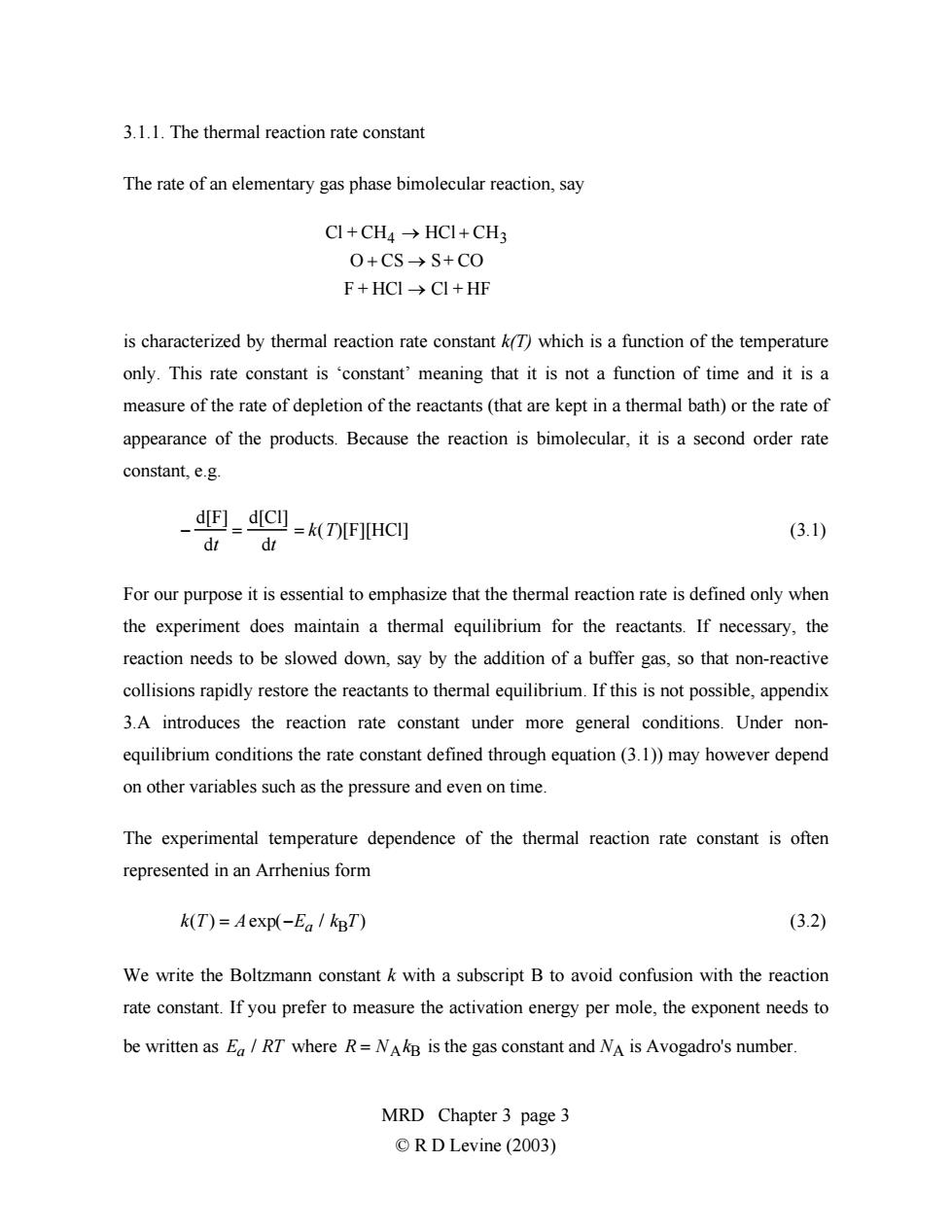正在加载图片...

3.1.1.The thermal reaction rate constant The rate of an elementary gas phase bimolecular reaction,say CI+CH4→HCI+CH3 O+CS→S+CO F+HCI→CI+HF is characterized by thermal reaction rate constant k(T)which is a function of the temperature only.This rate constant is 'constant'meaning that it is not a function of time and it is a measure of the rate of depletion of the reactants (that are kept in a thermal bath)or the rate of appearance of the products.Because the reaction is bimolecular,it is a second order rate constant,e.g. d四_dC=(LF]HC] (3.1) For our purpose it is essential to emphasize that the thermal reaction rate is defined only when the experiment does maintain a thermal equilibrium for the reactants.If necessary,the reaction needs to be slowed down,say by the addition of a buffer gas,so that non-reactive collisions rapidly restore the reactants to thermal equilibrium.If this is not possible,appendix 3.A introduces the reaction rate constant under more general conditions.Under non- equilibrium conditions the rate constant defined through equation(3.1))may however depend on other variables such as the pressure and even on time. The experimental temperature dependence of the thermal reaction rate constant is often represented in an Arrhenius form k(T)=Aexp(-Ea/kBT) (3.2) We write the Boltzmann constant k with a subscript B to avoid confusion with the reaction rate constant.If you prefer to measure the activation energy per mole,the exponent needs to be written as Ea/RT where R=NAkB is the gas constant and NA is Avogadro's number. MRD Chapter 3 page 3 ©R D Levine(2003)3.1.1. The thermal reaction rate constant The rate of an elementary gas phase bimolecular reaction, say Cl + CH4 → HCl + CH3 O + CS → S+ CO F + HCl → Cl + HF is characterized by thermal reaction rate constant k(T) which is a function of the temperature only. This rate constant is ‘constant’ meaning that it is not a function of time and it is a measure of the rate of depletion of the reactants (that are kept in a thermal bath) or the rate of appearance of the products. Because the reaction is bimolecular, it is a second order rate constant, e.g. − d[F] dt = d[Cl] dt = k(T)[F][HCl] (3.1) For our purpose it is essential to emphasize that the thermal reaction rate is defined only when the experiment does maintain a thermal equilibrium for the reactants. If necessary, the reaction needs to be slowed down, say by the addition of a buffer gas, so that non-reactive collisions rapidly restore the reactants to thermal equilibrium. If this is not possible, appendix 3.A introduces the reaction rate constant under more general conditions. Under nonequilibrium conditions the rate constant defined through equation (3.1)) may however depend on other variables such as the pressure and even on time. The experimental temperature dependence of the thermal reaction rate constant is often represented in an Arrhenius form k(T) = Aexp(−Ea / kBT) (3.2) We write the Boltzmann constant k with a subscript B to avoid confusion with the reaction rate constant. If you prefer to measure the activation energy per mole, the exponent needs to be written as Ea / RT where R = NAkB is the gas constant and NA is Avogadro's number. MRD Chapter 3 page 3 © R D Levine (2003)